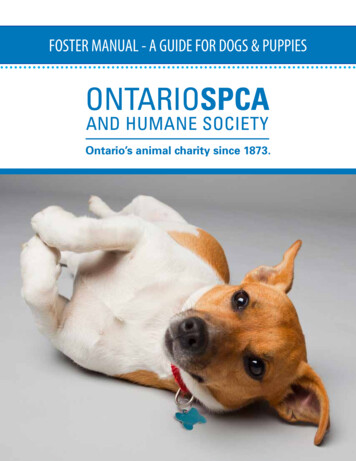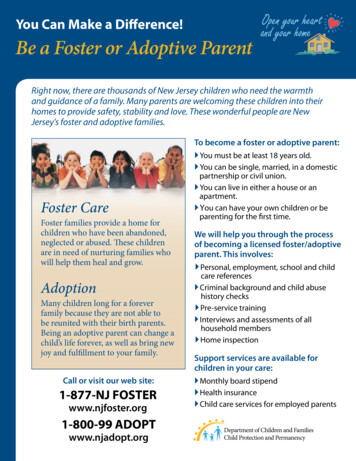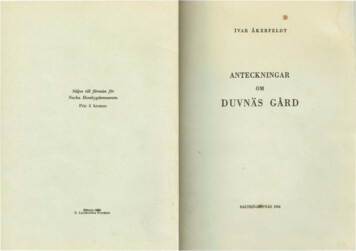
Transcription
FOSTER MANUAL - A GUIDE FOR DOGS & PUPPIES
Welcome to the Ontario SPCA Foster Care Program!You can change the life of a dog or puppy by becoming a fostervolunteer and opening your home and heart to a foster friend.TOP TIPS2Have fun!Make time to play with your foster dog or puppy!Take lots of photos and videos to promote your foster friend!Tell all your friends and family! Share with us and please shareon your social media!Make it a family project!Again, have fun!
Is Fostering Right for You?There are many things to considerwhen deciding to foster an animal.Foster caregivers must: Be at least 18 years oldComplete a foster care application andsign a foster care agreementSign up as an “on-deck” foster, ready to pick upyour dog or puppy within a 36-hour time frameBe able to set aside time (as often as every twoweeks for puppies) to bring your foster animal in for follow-up vaccinations and spay/neuter surgeryTake on the responsibility for routine care in your home during the foster periodEnsure that animals can be fostered in your homeIsolate foster animals from family pets within the home, as requiredQuarantine your foster animals for 14 days to prevent disease spread, as requiredPuppy-proof your home to reduce potential safety hazardsMaintain a peaceful, loving environment for the foster animals and spend quality time socializing themUtilize the emergency contact number for after-hour emergenciesMaintain communication with the Foster Program coordinatorCommit to the entire foster period with the animalTry to spend a minimum of two hours per day with puppies to socialize them and monitor their health (timecommitments will vary depending on your foster animals). For socialization and enrichment ideas visitshelterhealthpro.comIn addition: Existing animals in your home must be up-to-date on vaccines and in good healthEvery family member in the household will need to be prepared for the commitment and emotions involvedwith fostering3
Table of ContentsHow the Foster Program worksWhat are the risks?Preparing your home and familyPicking up your foster dog or puppyGetting acquainted with your new dog or puppyInteraction with childrenIntroducing foster dogs or puppies to your petsStart showcasing your foster dogDaily careGrooming and bathingMedicationBehaviourPuppy Growth MilestonesDaily cleaningSocializationWellness appointmentsVeterinary careEmergenciesBites or scratchesReturning your foster dog or puppyAdopting your foster dog or puppyPreparing for your next foster dogAppendix A: Daily Evaluation SheetAppendix B: Cleaning for Infection Control in the Foster HomeAppendix C: Health information: diseases and 2333537
How the Foster Program Works A list of available foster homes is maintained by the animal centre Foster Program coordinator Once a dog or puppy is identified as a candidate for foster care, the animal centre staff will develop anAnimal Care Plan and determine the length of time required for foster care Potential foster care volunteers are contacted and a placement will be confirmed A time is arranged for the foster volunteer to pick up the foster dog or puppy and supplies The animal centre staff will review with the foster volunteer the foster animal’s Animal Care Plan, includingany appointments for return visits to the animal centre The foster volunteer provides daily care and interaction, as well as monitoring of health and behaviour ofthe foster animal The animal centre staff remain available to provide any resources or support required to ensure a successfulfoster placement for both the dog or puppy and the foster volunteer The Foster Program coordinator will periodically check in to monitor the foster animal’s progress The foster animal is returned to the animal centre for adoption The foster volunteer will be asked to provide information on their foster dog or puppy that can be sharedwith potential adopters5
What are the Risks Involved?Are there any risks to people?The background of foster pets before entering the animal centre is not always known. You should be aware that bringing afoster dog or puppy into your home does come with some associated risks. At the animal centre, your foster pet will havehad at least one set of core vaccines and will have begun parasite treatment, but they still could be carrying intestinalbacteria, parasites or other zoonotic agents.Zoonoses are diseases of animals that can be transmitted to humans. Transmission may be direct (bites, secretions,excretions), or indirect (carried on clothing, equipment or through the air). The majority of diseases are not zoonotic;they are species-specific and affect only one or a few related species. Anyone can contract a zoonotic disease, however animmunosuppressive condition that limits a person’s ability to fight off disease increases risk. Risk factors include age (veryyoung or elderly,) illness, certain cancers (e.g. leukemia) and chemotherapy. Any concerns should be directed to yourpersonal physician.Find more information on Zoonoses ublic-healthYou can reduce the risks of spreading disease by using good hygiene practices. Hand washing after handling foster dogsand properly cleaning up.For more information on proper hand washing, tory/how-to-handwash.pdfIs there any risk to my pets?You can take steps to protect your pets. The Ontario SPCA requires that before bringing a foster animal into your home, youensure that your own animals are up to date on vaccines and parasite treatment and are in good health. As with people,there are some animals that are at increased risk of infection. These include the very young, very old, pregnant and petswith compromised immune systems. Please discuss any concerns with your veterinarian. You will also keep the foster dogor puppy in a separate area from your pets for at least the first 14 days to further protect your pets.6
Preparing Your Home and Family to FosterFirst you will complete your volunteer and foster training. Then you are ready to begin fostering a dog or puppy. A staffmember from the animal centre will contact you when a foster animal is a potential match for your home. Before youreceive that call, plan where foster pets will stay and discuss arrangements with your family. Please remember to let theFoster Program coordinator know if you have any changes to your contact information or your availability to foster.Choose a space for your foster dog or puppyA relatively warm and quiet indoor space in the home is the ideal place for your foster pet. This should be a well ventilated,easy-to-clean area where a foster animal can be segregated from your pets. A basement room, spare bedroom, or laundryroom that can accommodate a large portable crate or exercise pen generally works well, provided it can be shut off fromthe rest of the house. Remember that not all animals in the foster program have been house-trained, especially youngpuppies, so choose a space that is easy to clean and disinfect.7
Pet-Proof the space from potential hazards (Courtesy of the ASPCA) Remove small, ingestible objects from the environment; this may include small toys or parts of toys, elastic bands,paper clips, string, sewing pins and needles, ornaments, tinsel and more. Do not let your foster dogs or puppies outdoors alone under any circumstances. They should always be on leash, orsupervised in a secure fenced yard. When on a walk, do not allow interaction with other dogs. While in the home, keep them separated from any resident animals in a confined space such as the crate you areprovided with or in a spare room such as an extra bathroom. Keep toilet bowls securely closed, especially when small puppies are in the home Secure window screens in any open windows no matter how small the opening Ensure that side panels on window AC units are securely in place and cannot be moved or opened Secure loose electrical wires, cords for window blinds and other potential hazards Remove plants and flowers from the vicinity of your foster dog or puppy’s space; many types of decorative vegetationare highly toxic to animals Do not offer any human food to your foster animal unless specifically advised for training purposes, such as usingcheese cubes, or cut up hotdogs. Keep your home reasonably climate-controlled (if it’s too hot for you, it’s too hot for your foster pet) Ensure visitors do not leave doors or windows open, and are aware and conscientious about safety measures that are inplace for your foster dog or puppy Discard old or uneaten animal food and keep fresh water available at all times Secure/remove household toxins such as cleaning agents, pesticides and solventsWhat supplies do I need to get started?The Ontario SPCA will supply all of the items needed to properly care for your foster dog or puppy during its stay in yourhome, including food and medications. If you would like to supplement some of the supplies on your own please feel freeto discuss with the Foster Program coordinator.8
Picking Up Your Foster Dog or PuppyOnce you have been matched with a foster animal and your home has been prepared for your foster dog or puppy’s arrival,a date and time will be arranged for you to pick up your foster pet.Upon arrival at the animal centre, a staff member will review the dog or puppy’s Animal Care Plan with you, and will ensurethat you have all the supplies you will need to get started. You are on your way with your foster friend!On Route:Dogs and puppies fostered for the Ontario SPCA should remain ona leash and can be placed in an appropriate sized crate or in theenclosed rear of a vehicle. At no time will a dog be transported in theopen end of a vehicle or loose in a truck with a rear cap. The dog orpuppy must not be left unattended in the vehicle at any time.You’ve Arrived Home:Set up your foster dog or puppy’s new living space before bringingthem home. Have the food and water bowls, puppy pads ornewspaper, toys and bed/crate/exercise pen in place, and allowthem to explore the room.Take your foster dog for a brief walk around your yard to help thedog relieve stress and acclimatize to his new area. Once inside,keep the dog on a leash and walk him through the areas of yourhome that he will have access to.NOTE: Dogs fostered for the Ontario SPCA are to be kept on leash and/orsupervised in a securely fenced yard at all times while outside.9
Getting Acquainted with your New Dog or PuppyBeing in a new environment is stressful for most animals, and a normalreaction may be to hide.Safe Haven: Allow your foster dog time to adjust to your home whilebeing housed in a “safe haven” such as the crate provided or a separateroom. Spending some quiet time sitting in the room with your dog, whileoffering high value treats such as cheese cubes, may help them adjust,and associate you and the space with good things like yummy treats!Scared Dogs: Scared dogs may need some time to slowly adapt toyou and their new environment. Let them approach you at their pace,and never force them to interact. Offering treats from a distance, or justallowing them to have some quiet time on their own may help with thetransition. Scared dogs can dash out the front door in fear, and will be verydifficult to recall. Allow the dog to investigate the home, always givingthem the option to return to their safe place, such as their crate, or room.Take It Slow: Let your foster dog get used to you slowly. Sit in the room and have treats with you. Read a newspaper or abook out loud while you’re sitting there so the dog gets to know your voice. Offer treats to your foster dog in moderation.Never stare directly at your dog or stand or loom over your dog as your dog may feel threatened. Lure with treats andgentle encouragement when going outside on leash. Scared dogs may be difficult to recall when out loose in the yard, willkeep their distance, and may look for an escape route, it’s best to keep them on a leash.Fear Response: If your dog runs when you enter the room, tries to hide, slinks around the room with his body low to theground, ears back, tail tucked, or growls or cowers, recognize that these are signs of fear. The dog may escalate to bitingif he feels cornered with no escape. If the dog is not responding to slow interaction as described above, contact the FosterProgram coordinator immediately.It’s All Normal: Some dogs may need less than a day to adjust; others may need days or weeks to become comfortableenough to explore the entire house without fear. This is normal dog behavior.10
Interaction with Children in the HomeFostering can be a wonderful opportunity to teach children about respecting and caring for animals and a greatsocialization opportunity for the foster dog or puppy.Everyone in your family will also have to be prepared for the emotional highs and lows that can come with receiving, takingcare of, and returning a foster dog or puppy.We encourage families to share in the responsibility of caring for their foster pets, but we do require that children aresupervised at all times during this interaction. Please speak to your Foster Program coordinator for best practices whenintroducing your children to your foster pet.Introducing Foster Dogs and Puppies to Resident PetsIf you want to introduce your foster dog or puppy to your resident pets after the 14-day minimum quarantine, you mustfirst contact the Foster Program coordinator. They will be able to provide you with guidelines for introductions, and howto do so safely for both people and dogs. Dogs or puppies should not be introduced to resident pets unless they are free ofsigns of disease.11
Start Showcasing Your Foster Dog or PuppyWeb PresencePhotosWe can share your dog or puppy’s story on our socialmedia. Please share on your social media, too! If you writea story about the dog or puppy’s personality you can makea big difference in the number of calls the dog gets, so bedescriptive.Got a great photo or video of your foster dog or puppy?Please e-mail them in .jpg format for photos and .mpgformat for videos to the Foster Program coordinator withyour story.Try to include things like: Whether the dog likes to be petted or get belly rubs Favorite toys and games Knows basic verbal cues such as sit, or shake a paw,or does some tricks Is active and playful or calm Is housed-trained Has experience with other animals and children, etc.Of course, any cute things that he does or anything youwant to point out about his personality or appearance isgood as well. It can be as long as you want, but the typicaldescription is a paragraph or two.Try to focus on the positive, so we generate interest. Anybad habits can be discussed during the first conversationwith the potential adopter.Please e-mail the story to the Foster Program coordinator.12For photos and descriptions thatentice adopters, check out thesetechniques from ASPCApro:Hotshots-Getting Great Photos of YourAnimals: All By Your-Selfie: -selfie
Daily CareDaily Care for Dogs with PuppiesMost mothers, even first-timers, can take care of themselves and their offspring quite well. For the most part, you will leavemom and babies alone while observing for any signs of trouble.Provide a whelping box for nursing mothers, so babies can’t get out, but mom can when she needs some peace and quiet.Only half of the whelping box should have extra warmth added.Young Puppy CareA puppy’s survival depends on getting consistent nutrition and warmth. The mother’s colostrum, which is the first milkproduced, is vitally important to a newborn’s cardiovascular system and defense against disease. Colostrum is rich inantibodies to help protect against various infections, but puppies can only absorb these antibodies and benefit from themfor a short period after birth.So-called “Fading Puppy Syndrome,” when a newborn fades and dies despite adequate care, is usually due to either agenetic defect or lack of sufficient colostrum. For this reason, it is very important that newborns nurse as soon as possibleafter birth. If they do not find a nipple on their own, put their mouth close to one and hold them until they nurse.Continued healthy nursing behavior is crucial for puppy survival. In order to tell if the puppies are nursing, put on examgloves and gently pick up each puppy and feel for a round belly full of milk. A flat or concave belly indicates that the puppymay not be nursing. You should perform this check once or twice a day, always wearing your exam gloves.Also, visually confirm that each puppy is actually latching onto mom. A gram scale works great to log each puppy’s weighton your health monitoring sheet (found later in this guide). Healthy puppies should gain a little weight each day.Problem SignsDuring the first two weeks, puppies should spend approximately 90% of the time eating and sleeping. If puppies are cryingduring or after eating, they are usually becoming ill or are not getting adequate milk.A newborn puppy is very susceptible to infections and can die within 24 hours. If excessive crying occurs, the mother andentire litter should be examined by a veterinarian. Please call us immediately.13
Daily Care for Puppies Transitioning to WetFood (3-5 weeks)Daily Care for Puppies Eating on their Own(5-8 weeks)Transitioning puppies should be fed “gruel,” which is apudding-like consistency mix of canned puppy food andwarm water. They should be fed every 4-6 hours. Pleasenotify your animal centre if you notice the puppies are nottaking to the canned food. You are welcome to experimentwith different consistencies but the gruel should begradually thickened to get them ready for solid food.Adding softened kibble can help thicken it up. Leftovergruel should be discarded immediately if not eaten.Canned food that has not been made into gruel yet can becovered and refrigerated for up to 48 hours.Puppies who are eating completely on their own will needOnce puppies have teeth, they could start to chew the nippleon a bottle, which can be very dangerous due to small piecesbeing ingested. This must be monitored closely.to be fed wet food or softened kibble about four timesthroughout the day. They should always have water available.Don’t forget to clean their puppy pen or room frequently,since active puppies can be messy.Puppies at this age can also start going outside. If theweather permits, you can even feed them outside in asecure area, allow playtime, and time to urinate anddefecate before bringing them back inside!Adult DogsFresh water should be provided at all times fortransitioning puppies.Adult dogs are fed twice daily. You will be provided withthe appropriate food and instructions. Adults may or maynot be house-trained. Be sure to take them outside aftereating, drinking, playing or sleeping.To encourage a puppy to eat the gruel, place a smallamount on your finger and place it on the puppy’s tongueor lips. The goal is that she will eat on her own from a plateor bowl. This transition period can take days to weeks.Puppy pads or newspaper should be provided at this stage,away from their eating and sleeping area, as they willeventually learn to urinate and defecate away from theareas they eat, sleep and play. You can also place puppieson the puppy pad or newspaper after meals.Reward them for going outside with treats and praise.If an accident happens in the house, do not scold the dog.Simply ignore, clean up, and take the dog outside. Be sureto give a reward every time the dog goes outside, so that hewill very quickly associate the outdoor bathroom with goodthings. Supervise the dog while in the house and watchfor telltale signs such as circling or sniffing. House-trainingusually takes a week or two, although you may have someaccidents as you work out a scheduled routine.14
Grooming and BathingAdults: Groom your foster dog regularly (daily if possible)with a soft bristle brush. Brushing is an important part ofroutine care for dogs. The animal centre staff can help withpositive association to nail trimming during one of yourscheduled visits to the animal centre.If your foster dog requires bathing as part of the treatmentplan, the animal centre staff will discuss this with you aspart of the Animal Care Plan. Otherwise, if you feel yourfoster dog may need bathing, please call and discuss withthe animal centre staff prior to bathing.Puppies: Puppies should be kept clean and will oftenneed bathing since they can be very messy. Try to spotclean by only rinsing the puppy with warm water wherehe is dirty, such as his bottom. Make sure to not get a lotof water on his head, especially the eyes, nose and ears.If there is food stuck on his face, use a warm, damp cloth.Puppies cannot be put back into their home until they arecompletely dry. You can use a blow dryer on the lowestsetting after towel drying.As with adults, grooming and brushing is an importantpart of routine care for your puppies and can also be animportant part of their socialization.MedicationIf your foster dog or puppy requires medication at the time of pick up, information about the medication, includingtype, dose and schedule will be recorded on the Animal Care Plan. Additionally, a medication log will be providedto you that includes specific dates and times to be initialed after each dose is given. Keeping detailed records ofmedication doses is important! It is also important that medication is given as directed. Never stop giving medication before it is finished. If you have any questions or concerns regarding medication for your foster dog, contact theAnimal Centre right away.15
BehaviourMonitoring your Dog or Puppy’s Healthand BehaviourIt is important to monitor your foster dog or puppy’s healthdaily. You will need to watch your foster dog or puppyclosely for any changes to his/her health and activity levels.You will receive a Daily Evaluation Sheet (Appendix B)to track the various physical and behavioural signs.Any changes should be recorded and discussed withthe Foster Program coordinator.Behaviour to watch out for:If you notice any of the following behaviours OR anybehaviour you are uncomfortable or unsure of, contact theanimal centre as soon as possible to discuss: 16Growling, lip curling, snarling, snapping or bitingtowards people or other animalsAvoidance (fear ) of people, animal or objectsReactivity (lunging) at people or animalsPossessiveness or guarding of food, toys orother resourcesReluctance, avoidance or sensitivity to touch
Puppy Growth Milestones* Puppy Growth Milestones Courtesy of University of WI Shelter Medicine ProgramAgeMilestones1 week Newborns can nurse up to 45 minutes at a timeThe temperature of the nest box should be nice and warm: 85-90 degreesAt one week of age, the puppies should be handled minimallyPuppies will sleep 90% of the time and eat the other 10%1-2 weeks Ear canals open between 5 and 8 daysEyes will open between 8 and 14 daysHealthy puppies will be round and warm, with pink skinHealthy puppies seldom cry Puppies begin to crawl around day 18 and can stand by day 21They will begin to play with each other, biting ears, tails and learn to sit and touch objects with their pawsPuppies begin their socialization phase - they will be strongly influenced by the behaviour of their motherfor the next six weeksTo further socialize puppies, increase the amount of handling, and get them accustomed to human contact,ensuring gentle handlingIt is important not to expose them to anything frightening3-4 weeks Puppies may start lapping from a bowlAdult eye color will begin to appear, but may not reach final shade for another 9 to 12 weeksPuppies begin to see well and their eyes begin to look and function like adult dogs’ eyesPuppies will start cleaning themselves4-5 weeks Puppies usually can drink and eat from a saucer by 4 weeksCan begin housebreaking at four weeks of ageReady for 1st vaccine Able to start eating dry foodThey will wash themselves, play games with each other, their toys, and you, and many will come when you call themGradual introduction to novel items, places, people, and soundsReady for 2nd vaccineSpay / neuter: puppies can be spayed and neutered from 6 weeks of age, with a minimum bodyweight of 2 lbs Pair introductions to new things with rewards to promote a positive experienceReady for Adoption!2-3 weeks 5-7 weeks7-8 weeks17
Daily CleaningProviding a clean, sanitary living space dedicated to just your foster dog or puppy is a highly important part of caring foryour foster pet and lowering the risk of the transmission of zoonotic and infectious disease.Five key practices to control disease transmission include: Practicing good hand hygiene before and after handing animals or objects in the foster area Cleaning and disinfecting items in the foster area using the appropriate products Ensuring surfaces that are easy to clean and disinfect (vinyl or tile floor, not carpet, if possible) Stocking the area with animal care supplies that are dedicated to the area and easy to disinfect Keeping human traffic to a minimumThere are some quick and easy steps you will need to take daily to ensure your home and your foster petremain healthy and happy: Wash your hands before and after each interaction with your foster pet Wear disposable gloves while cleaning or picking up feces or soiled newspaper Wash food and water bowls daily Remove any organic materials (feces, urine, fur, food) from bedding, floor, furniture etc. Wipe up any organic material using spray bottle of Prevail and paper towel Wash and thoroughly dry bedding, if soiled Pick up feces outside immediately Consider wearing a smock or other protective wear to avoid direct contact with your clothing that comes in contactwith other animals18
Cleaning vs. DisinfectingCleaning removes dirt, grease orvisible debris from surfaces, typicallythrough the use of soap, detergent, ordegreaser. Cleaning does not removeharmful organisms. Cleaning of theanimal housing area, as describedabove, should be undertaken daily.Disinfecting removes harmfulorganisms through a chemical agent.Disinfectants do not always removedirt or grease. Disinfecting is usuallydone only after a surface is thoroughlycleaned.A thorough cleaning, followed bydisinfection is required of all suppliesand the animal housing area betweenfoster animals and/or any time ananimal has been ill or any type ofhealth concern has been identified.Supplementary resource:Appendix B : Cleaning for InfectionControl in the Foster Home19
During the quarantine period:Surface/ObjectSuggested ProcedureSpecial StepHigh contact surfaces (counters, lightswitches and floors)Daily cleaning using detergent and watersolution or spray bottle of Prevail andpaper towel. Weekly disinfection usingPrevail and allowing a five-minute wetcontact time with disinfectant on cleanedsurfaces.Sweep all floors daily. Vacuum all rugs andfurniture vigorously and frequently!Visibly soiled objects/ surfacesClean with a detergent and water solutionand spray with Prevail to allow for a fiveminute wet contact time.Food & water bowlsDaily cleaning and weekly disinfectionwith Prevail .Towel dry or air dry.All regular surfaces (any surface your fosteranimal comes in contact with like walls,blinds, etc.)Weekly cleaning and disinfection withPrevail .Increase frequency of cleaning and disinfection to daily when infection is present.Laundry (bedding, blankets and sometoys)Remove organic material beforelaundering.Use detergent and water temperatureappropriate for fabrics. Bleach may be usedfor stain removal.Thoroughly machine dry on highest heatthe fabric will tolerate.Take caution in moving soiled items towashing machine to prevent environmental contamination.Throw away heavily soiled items andrequest replacements from animal centre.Exercise pens or crateClean with a detergent and water solutionand spray with Prevail to allow for a fiveminute wet contact time.Towel dry or let air dry.After the quarantine period: Continue with daily cleaning of food and water bowls, removal of soiled puppy pads,newspaper or bedding, daily wiping up any organic material and cleaning with spray bottle of Prevail and paper towel.20
Once Your Foster Dog or Puppy has Been ReturnedSurface/ObjectSuggested ProcedureSpecial StepAll surfaces and objectsThorough cleaning and disinfection (usingPrevail disinfectant) between eachanimal’s stay in your home.Thoroughly clean surfaces with a soap ordetergent, and then apply Prevail using aspray bottle to allow for a five-minute wetcontact time. Allow to air dry or wipe dryafter five minutes.Floors and carpetsSweep and wash all floors. Apply Prevail using spray bottle to allow for a fiveminute wet contact time. For carpets,vigorously vacuum and overspray withPrevail solution.Change vacuum bag if used.Exercise pens or crateClean with a detergent and water solutionand spray with Prevail to allow for a fiveminute wet contact time.Towel dry or let air dry.Laundry (bedding, blankets and sometoys)Remove organic material beforelaundering.Use detergent and water temperatureappropriate for fabrics. Bleach may be usedfor stain removal.Thoroughly machine dry on highest heatthe fabric will tolerate.Take caution in moving soiled items towashing machine to prevent environmental contamination.Throw away heavily soiled items andrequest replacements from animal centre.Laundry (bedding, blankets and sometoys)Clean with a detergent and water solutionand spray with Prevail to allow for a fiveminute wet contact time.Towel dry or let air dry.21
SocializationYou can help set your foster dog or puppy up for success through regular handling and play. The more comfortable theyare interacting with people, the more social and attractive they
Puppy Growth Milestones Daily cleaning Socialization Wellness appointments Veterinary care Emergencies Bites or scratches Returning your foster dog or puppy Adopting your foster dog or puppy Preparing for your next foster dog Appendix A: Daily Evaluation Sheet Appendix B: Cleaning for Infection Control in the Foster Home










